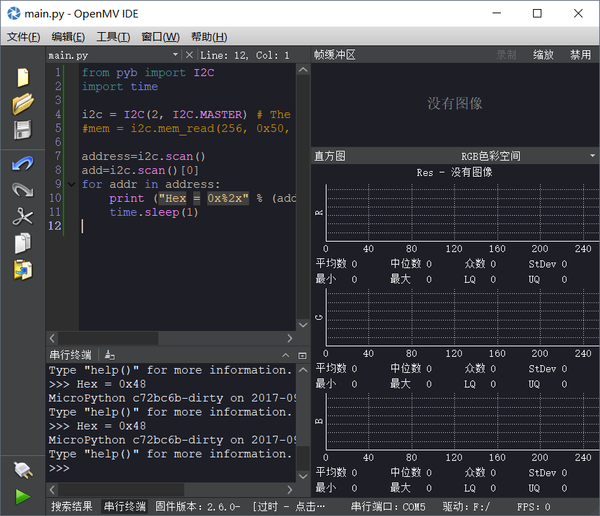MicroMV IIC通信
MicroMV上的IIC通讯
- 做为IIC主机
- 扫描设备地址
from pyb import I2C i2c = I2C(2, I2C.MASTER) # The i2c bus must always be 2. address=i2c.scan() for addr in address: print ("Hex = 0x%2x" % (addr))
- 做为IIC从机
# I2C with the Arduino as the master device and the OpenMV Cam as the slave. # # Please wire up your OpenMV Cam to your Arduino like this: # # OpenMV Cam Master I2C Data (P5) - Arduino Uno Data (A4) # OpenMV Cam Master I2C Clock (P4) - Arduino Uno Clock (A5) # OpenMV Cam Ground - Arduino Ground import pyb, ustruct text = "Hello World!\n" data = ustruct.pack("<%ds" % len(text), text) # Use "ustruct" to build data packets to send. # "<" puts the data in the struct in little endian order. # "%ds" puts a string in the data stream. E.g. "13s" for "Hello World!\n" (13 chars). # See https://docs.python.org/3/library/struct.html # READ ME!!! # # Please understand that when your OpenMV Cam is not the I2C master it may miss responding to # sending data as a I2C slave no matter if you call "i2c.send()" in an interupt callback or in the # main loop below. When this happens the Arduino will get a NAK and have to try reading from the # OpenMV Cam again. Note that both the Arduino and OpenMV Cam I2C drivers are not good at getting # unstuck after encountering any I2C errors. On the OpenMV Cam and Arduino you can recover by # de-initing and then re-initing the I2C peripherals. # The hardware I2C bus for your OpenMV Cam is always I2C bus 2. bus = pyb.I2C(2, pyb.I2C.SLAVE, addr=0x12) bus.deinit() # Fully reset I2C device... bus = pyb.I2C(2, pyb.I2C.SLAVE, addr=0x12) print("Waiting for Arduino...") while(True): try: bus.send(ustruct.pack("<h", len(data)), timeout=10000) # Send the len first (16-bits). try: bus.send(data, timeout=10000) # Send the data second. print("Sent Data!") # Only reached on no error. except OSError as err: pass # Don't care about errors - so pass. # Note that there are 3 possible errors. A timeout error, a general purpose error, or # a busy error. The error codes are 116, 5, 16 respectively for "err.arg[0]". except OSError as err: pass # Don't care about errors - so pass. # Note that there are 3 possible errors. A timeout error, a general purpose error, or # a busy error. The error codes are 116, 5, 16 respectively for "err.arg[0]". ################################################################################################### # Arduino Code ################################################################################################### # # #include <Wire.h> # #define BAUD_RATE 19200 # #define CHAR_BUF 128 # # void setup() { # Serial.begin(BAUD_RATE); # Wire.begin(); # delay(1000); // Give the OpenMV Cam time to bootup. # } # # void loop() { # int32_t temp = 0; # char buff[CHAR_BUF] = {0}; # # Wire.requestFrom(0x12, 2); # if(Wire.available() == 2) { // got length? # # temp = Wire.read() | (Wire.read() << 8); # delay(1); // Give some setup time... # # Wire.requestFrom(0x12, temp); # if(Wire.available() == temp) { // got full message? # # temp = 0; # while(Wire.available()) buff[temp++] = Wire.read(); # # } else { # while(Wire.available()) Wire.read(); // Toss garbage bytes. # } # } else { # while(Wire.available()) Wire.read(); // Toss garbage bytes. # } # # Serial.print(buff); # delay(1); // Don't loop to quickly. # }
